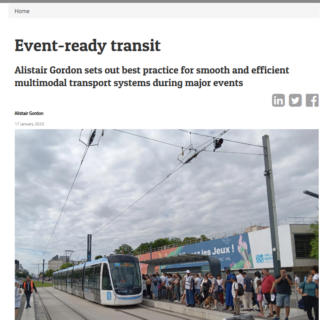Alistair Gordon, Chief Executive of Keolis UK, Ireland, Middle East & India, shares his thoughts on managing complex multimodal transport networks during high-profile, global events in a recent feature on TransportXtra.
Event-ready transit
Some 11 million people from 206 countries descended on Paris for this summer’s Olympic and Paralympic Games. The opening ceremony – showcasing the best of the city’s sporting, artistic and cultural heritage – attracted 358,000 spectators alone.
The excitement wasn’t confined to Paris. While the first week of the Games saw a 42% increase in tourists traveling to the capital, host cities like Lille, Saint-Etienne and Marseille also saw a surge in visitors.
Naturally, this influx put a strain on the country’s transport networks. And, without systems in place to handle massive increases in ridership, there’s a huge risk of disruption that can easily spoil a visitor’s experience of the event.
This is where experience and expertise in managing multimodal transport systems during high-profile events become essential – and that’s where Keolis steps in.
With a presence in countries throughout Europe, the Middle East, India, USA, Australia and China and back to the UK, we’ve frequently been called into action to ensure the safe transit of people during major events. In the last few years alone these have included the rugby World Cup in France, the football World Cup in Qatar and the aforementioned Olympics. Indeed, the Olympics this year saw us transport 10,500 athletes in Paris alone and mobilise around 1,000 employees – all with a punctuality rate of 97%.
As well as these one-off large events, we are responsible for the management of transport to a large number of regular showpiece events on our networks, such as the London Marathon on the Docklands Light Railway in London and Parklife on the Manchester Metrolink tram network. We also oversaw the transport of around 8.2 million attendees to Expo 2020 in Dubai on its metro system.
So, what have we learnt along the way?
Embracing technology
First, it’s important to embrace the shift to new technologies to meet increases in passenger numbers.
Take the Doha Metro. It’s a driverless, automated system which uses communication-based train control (CBTC) technology and wi-fi to talk to computers that manage the trains and monitor potential traffic, helping the whole system. At times of substantial increases in passenger numbers, such as during the World Cup, this technology ensures the trains are timed efficiently and users have a reliable and easy travel experience, and also helps inform decisions around deploying additional train capacity on the network when needed.
The simple matter of prioritising passenger information underscores a fundamental aspect of delivering quality public transport services. Real-time updates and responsive communication are essential components of a successful metro network and, by extension, broader multimodal public transportation systems.
Then there’s providing additional resources to central control centres, helping coordinate various teams and support functions and allowing for rapid and integrated responses to potential incidents. Customer experience personnel are embedded in the control centre to manage the delivery of accurate and up to date customer information to passengers, benefiting from working in close proximity to their operational colleagues.
This approach was key to achieving a 99.81% reliability record during the 2022 World Cup, demonstrating the importance of centralised management and communication for delivering quality public transport services.
Prioritising efficiencies is also vital. Looking to how we operate the multimodal network in Dijon, for example, we see a system that seamlessly connects with local bus networks and feeder systems, making most neighbourhoods accessible.
We’ve also implemented contactless payment terminals on all of the city’s trams and buses to streamline the passenger experience, making ticket purchasing easier and allowing riders to enjoy a more seamless journey hopping onto another mode of transport.
With the introduction of a Mobility as a Service (MaaS) app, Keolis worked with the transport authority to enhance the passenger experience even further by integrating all public transport options in Greater Dijon, including trams and buses, into a single platform. This app facilitates bookings, route searches, and real-time timetable updates. Additionally, the Bouquet Libertés, which Keolis launched in September 2021, allows users to combine their transport tickets – including buses, trams and car parking – and incentivises multimodal travel.
Powered by people
But even with the most sophisticated tech-led multimodal network it’s important not to underestimate the power of having focused individuals on the frontline to provide both customer service and people management.
Creating a masterplan that incorporates all stakeholders – from PTA through to emergency services – as well as contingency arrangements and command processes, is a good place to start. This can be continuously improved with ongoing review processes during and post-event.
Then there’s additional resource. Ahead of the World Cup, 5,000 extra support staff were recruited from outside Qatar, including 200 security guards and 500 technicians, all of whom underwent additional training. The approach to having a wealth of focused and engaged manpower was key to zero incidents being recorded throughout the entire tournament, underscoring the broader need for well-trained and engaged frontline staff in delivering an exceptional service.
Finally, we’ve also established a Centre of Excellence, which connects global experts to a dedicated central pool of specialists, to support every stage of a project’s lifecycle. This partnership drives ongoing improvements in our systems, enabling us to maximise the use of every mode of transport within complex networks through collecting, sharing and continuously improving best practices from across our networks.
Developing efficient, inclusive multimodal transport systems requires a tailored approach – there’s no one-size-fits-all solution.
It’s not easy, but there’s a gold medal in it for those that heed the above.
Read the article to see how Keolis supports cities in becoming “event-ready” for the future. Click here to read the article on TransportXtra.
